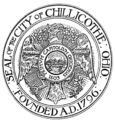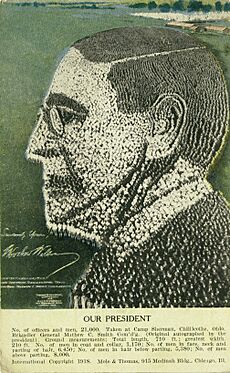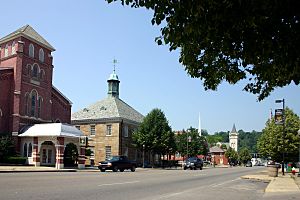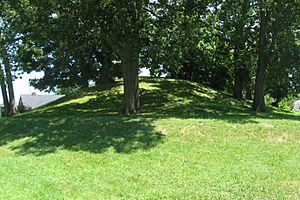Chillicothe, Ohio facts for kids
Quick facts for kids
Chillicothe
|
|||
|---|---|---|---|
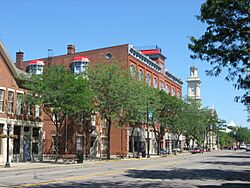
Central business district
|
|||
|
|||
| Nickname(s):
Ohio's First Capital
|
|||
| Country | United States | ||
| State | Ohio | ||
| County | Ross | ||
| Area | |||
| • Total | 10.67 sq mi (27.62 km2) | ||
| • Land | 10.50 sq mi (27.19 km2) | ||
| • Water | 0.17 sq mi (0.43 km2) | ||
| Elevation | 637 ft (194 m) | ||
| Population
(2020)
|
|||
| • Total | 22,059 | ||
| • Estimate
(2023)
|
21,895 | ||
| • Density | 2,100.86/sq mi (811.17/km2) | ||
| Time zone | UTC-5 (EST) | ||
| • Summer (DST) | UTC-4 (EDT) | ||
| ZIP code |
45601
|
||
| Area code(s) | 740, 220 | ||
| FIPS code | 39-14184 | ||
| GNIS feature ID | 2393514 | ||
| Website | https://www.chillicotheoh.gov/ | ||
Chillicothe is a city in Ohio, United States. It is the main city in Ross County. In 2020, about 22,059 people lived there. Chillicothe is located along the Scioto River, about 45 miles (72 km) south of Columbus. It was the very first capital of Ohio, and then the third capital too! It's also known as a Tree City USA, which means it cares about its trees and green spaces.
Contents
History of Chillicothe
The area around Chillicothe was once home to the ancient Hopewell tradition people. They lived here from about 200 BC to 500 AD. These early Americans built large earthen mounds for ceremonies and burials. They even traded with people as far away as the Rocky Mountains.
Later, Native American groups like the Shawnees lived in this region. The name "Chillicothe" comes from the Shawnee word Chala·ka·tha, which means "principal town." This name was used for the main town wherever the Chalakatha division of the Shawnee people settled.
After a peace treaty in 1795, European settlers began to move into Ohio. The town of Chillicothe was started in 1796 by General Nathaniel Massie. Many people from Virginia and Kentucky came looking for new land.
In 1800, Chillicothe became the capital of the Northwest Territory. This was a large area that included what is now Ohio. In 1802, a special meeting was held in Chillicothe to write Ohio's first constitution. When Ohio became a state in 1803, Chillicothe was its capital. It remained the capital until 1810, and then again from 1812 to 1816.
Ohio was a "free state," meaning slavery was not allowed. Many free African Americans moved to Chillicothe. They built a strong community and helped people who were escaping slavery. Chillicothe was an important stop on the Underground Railroad. This was a secret network that helped enslaved people travel north to freedom.
Geography of Chillicothe
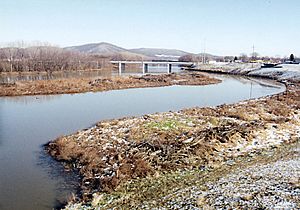
Chillicothe is located in a region called the Western Allegheny Plateau. It sits between the Scioto River and Paint Creek, where these two waterways meet.
The city covers about 10.60 square miles (27.45 square kilometers). Most of this area is land, with a small part being water. The city is surrounded by farms. People in Chillicothe often say the area is in the foothills of the Appalachians.
People of Chillicothe
Chillicothe is home to a diverse group of people. In 2020, the city had 22,059 residents. There were 9,576 homes, and 5,589 families living in the city.
The average age of people in Chillicothe was about 41.4 years old. About 21.1% of residents were under 18 years old. Around 20.6% were 65 years or older.
Most people in Chillicothe are White, but there are also many African American, Asian, and Native American residents. About 1,419 people identified as being of two or more races. The city is a mix of different backgrounds and cultures.
Economy in Chillicothe
Chillicothe is the main center for business in its area. It has many important employers. These include shopping malls, hospitals, and a college campus.
One of the most well-known businesses is the Pixelle paper mill. This mill has been making paper for over 100 years. It used to be known as Glatfelter and Mead Paper.
Arts and Culture in Chillicothe
Majestic Theatre
Chillicothe has a very old and special theater called the Majestic Theatre. It has been open for 158 years without stopping! Famous performers like Laurel and Hardy and Bob Hope have performed on its stage.
The building was first built in 1853 as the Masonic Hall. It was a place for meetings, dances, and plays. In 1876, it was made bigger and became known as the Masonic Opera House. People said it was one of the best theaters in Ohio.
Later, in 1914, the theater was bought by the Myers Brothers. They added a movie screen and changed its name to the Majestic Theatre. At first, they still had live shows sometimes, but then they mostly showed movies. Today, the Majestic Theatre is a non-profit organization. It has been carefully restored and continues to host shows and events.
Fairs and Festivals
Chillicothe celebrates its rich Native American history with the annual Feast of the Flowering Moon Festival. This festival started in 1984 and brings in about 85,000 visitors each May.
The festival takes place in Yoctangee Park in the downtown area. It's a fun event for families. You can enjoy Native American music and dancing. There are also traders and exhibits, and a "mountain men" camp where you can see craftsmen at work. Many artists and crafters sell their goods. The main stage features local school bands and other family-friendly entertainment. The streets are filled with food booths and games. Best of all, it's free to attend!
Parks and Recreation in Chillicothe
Chillicothe has many public parks where you can play and relax. Some of these parks include Yoctangee Park, Patrick Park, and Veterans Memorial Park.
Yoctangee Park is the largest park. It has baseball and softball fields, tennis courts, basketball courts, and playgrounds. There's also a skatepark called Henry Good skatepark, built with help from a local citizen.
The city also has a long paved bike path along its floodwall, which protects the city from the Scioto River. This path is 5.0 miles long. It connects to the Tri-County Triangle Trail, which is over 30 miles long. This trail is a great place for biking and walking.
The Hopewell Culture National Historical Park is located just north of Chillicothe. This park is managed by the National Park Service. It protects many ancient earthworks built by Native Americans long ago.
Sports in Chillicothe
Chillicothe has its own baseball team called the Chillicothe Paints. The team started in 1993. They used to play in the Frontier League and are now part of the Prospect League. The Paints play their home games at V.A. Memorial Stadium. This stadium opened in 1954.
V.A. Memorial Stadium has also hosted other sports events. These include college baseball tournaments and high school soccer and baseball playoff games.
Education in Chillicothe
The Chillicothe City School District runs several public schools for children in the city. There is also Bishop Flaget School, which is a private Catholic school. Ross County Christian Academy offers classes from kindergarten through 12th grade.
Chillicothe is also home to the Pickaway-Ross Career & Technology Center. This school, founded in 1974, helps students learn skills for different jobs.
Ohio University – Chillicothe is a local campus of Ohio University. It was the first regional campus of Ohio University, started in 1946. About 2,000 students attend this campus each year. Chillicothe also has the Recording Workshop, a school where students learn about audio engineering.
The city's public library system, the Chillicothe and Ross County Public Library, serves the community with a main branch and a Northside branch.
Notable People from Chillicothe
- Chet Allen (1939–1984) – An actor.
- William Allen (1803–1879) – A former Governor of Ohio.
- Scott Bailes (b. 1961) – A Major League Baseball (MLB) player.
- John Bennett (1865–1956) – A writer and illustrator.
- Carrie Williams Clifford (1862–1934) – An author and activist for women's rights and civil rights.
- Edward Cook (1888–1972) – A pole vaulter who competed in the 1908 Summer Olympics.
- Greg Cook (1946–2012) – A player in the National Football League (NFL).
- Joseph C. Corbin (1833–1911) – A journalist and educator who helped on the Underground Railroad.
- Edwin Dun (1848–1931) – An advisor on farming to Japan.
- Sarah J. W. Early (1825–1907) – An educator and author.
- Bobby Fulton (b. 1960) – A professional wrestler.
- Lucy W. Hayes (1831–1889) – The wife of President Rutherford B. Hayes and a former First Lady of the United States.
- James L. Herlihy (1927–1993) – A novelist, playwright, and actor.
- Tokey Hill (b. 1957) – A karate expert.
- Dard Hunter (1883–1966) – A papermaker and artist.
- Billy Ireland (1880–1935) – A cartoonist.
- Neil Johnston (1929–1978) – An NBA basketball player and NBA All-Star.
- Nathaniel Massie (1763–1813) – The founder of Chillicothe.
- Duncan McArthur (1772–1839) – A U.S. Army general and former Ohio governor.
- Gardner Murphy (1895–1979) – A famous psychologist.
- David L. Nickens (1794–1838) – The first African-American licensed minister in Ohio.
- Lerton Pinto (1899–1983) – A Major League Baseball (MLB) player.
- Frederick M. Roberts (1879–1952) – The first African-American elected to the California State Assembly.
- Noel Sickles (1910–1982) – An artist and cartoonist.
- Tecumseh (1768–1813) – A famous Shawnee chief and warrior, likely born near here.
- Allen G. Thurman (1813–1895) – A U.S. Senator for Ohio.
- Edward Tiffin (1776–1829) – The first Ohio Governor.
- Nancy Wilson (1937–2018) – A famous jazz singer and actress.
- Thomas Worthington (1773–1827) – A former Ohio Governor and U.S. Senator.
- John Yang (b. 1958) – A news correspondent and journalist.
Sister Cities
Chillicothe has special connections with other cities around the world.
- Chillicothe is a sister city with Córdoba, Veracruz, Mexico. Students from Chillicothe High School can take part in a Foreign Exchange Student Program with students from Córdoba.
- Chillicothe also had an agreement with Tulua, Valle del Cauca, Colombia. Because of this, a main lake in Tulua is named Lago Chilicote.
See also
 In Spanish: Chillicothe (Ohio) para niños
In Spanish: Chillicothe (Ohio) para niños



